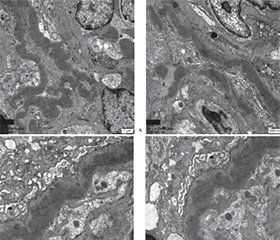Журнал «Почки» Том 13, №4, 2024
Вернуться к номеру
Діагностичні й терапевтичні проблеми при хворобі щільних депозитів: опис випадку
Авторы: Anand Prasad, Dhruv Jain, Navya Jaiswal, Harsha Shahi
Subharti Medical College, Swami Vivekanand Subharti University, Meerut, Uttar Pradesh, India
Рубрики: Нефрология
Разделы: Справочник специалиста
Версия для печати
Авторами наведено складний випадок у 15-річної дівчини, у якої був діагностований постстрептококовий гломерулонефрит (ПСГН), але пізніше виявлено захворювання щільних депозитів, яке спочатку було класифіковано як мембранопроліферативний гломерулонефрит 2-го типу. ПСГН і C3-гломерулопатія мають схожі клінічні й гістологічні ознаки, що ускладнює діагностику та лікування. У цьому випадку початкова клінічна картина та лікування ПСГН переросли в складну діагностику хвороби щільних депозитів, що потребувало індивідуальних терапевтичних втручань.
We report a complex case of a 15-year-old girl initially diagnosed with post-streptococcal glomerulonephritis (PSGN) but later identified as having dense deposit disease, which was initially classified as type 2 membranoproliferative glomerulonephritis. PSGN and C3 glomerulopathy present overlapping clinical and histological features, complicating diagnosis and treatment. This report highlights the case of a young patient whose initial presentation and management for PSGN transitioned to a complex diagnosis of dense deposit disease, necessitating tailored therapeutic interventions.
постстрептококовий гломерулонефрит; хвороба щільних депозитів; С3-гломерулопатія; мембранопроліферативний гломерулонефрит; базальна мембрана клубочка
post-streptococcal glomerulonephritis; dense deposit disease; C3 glomerulopathy; membranoproliferative glomerulonephritis; glomerular basement membrane
Для ознакомления с полным содержанием статьи необходимо оформить подписку на журнал.
- Sethi S, Fervenza FC, Zhang Y, Zand L, Meyer NC, Borsa N, et al. Atypical post-infectious glomerulonephritis is associated with abnormalities in the alternative pathway of complement. Kidney Int. 2013 Feb;83(2):293-9.
- Pickering MC, D’Agati VD, Nester CM, Smith RJ, Haas M, Appel GB, et al. C3 glomerulopathy: consensus report. Kidney Int. 2013 Dec;84(6):1079-89.
- Smith RJH, Appel GB, Blom AM, Cook HT, D’Agati VD, Fakhouri F, et al. C3 glomerulopathy — understanding a rare complement-driven renal disease. Nat Rev Nephrol. 2019 Mar;15(3):129-43.
- Kumar M, et al. Dense deposit disease: An ultra-rare c3 glomerulopathy in children. Available from: https://www.journal-ina.com/article.asp?issn=2394-2916;year=2018;volume=5;issue=1;spage=41;epage=43;aulast=Kumar.
- Taranta-Janusz K, Wasilewska A, Szynaka B. Childhood-onset dense deposit disease: a rare cause of proteinuria. Ir J Med Sci (1971–). 2014 Sep 1;183(3):455-9.
- Smith RJH, Alexander J, Barlow PN, Botto M, Cassavant TL, Cook HT, et al. New approaches to the treatment of dense deposit di–sease. J Am Soc Nephrol JASN. 2007 Sep;18(9):2447-56.
- Wada Y, Kamata M, Miyasaka R, Abe T, Kawamura S, Takeuchi K, et al. Clinico-Pathogenic Similarities and Differences between Infection-Related Glomerulonephritis and C3 Glomerulopathy. Int J Mol Sci. 2023 May 8;24(9):8432.

